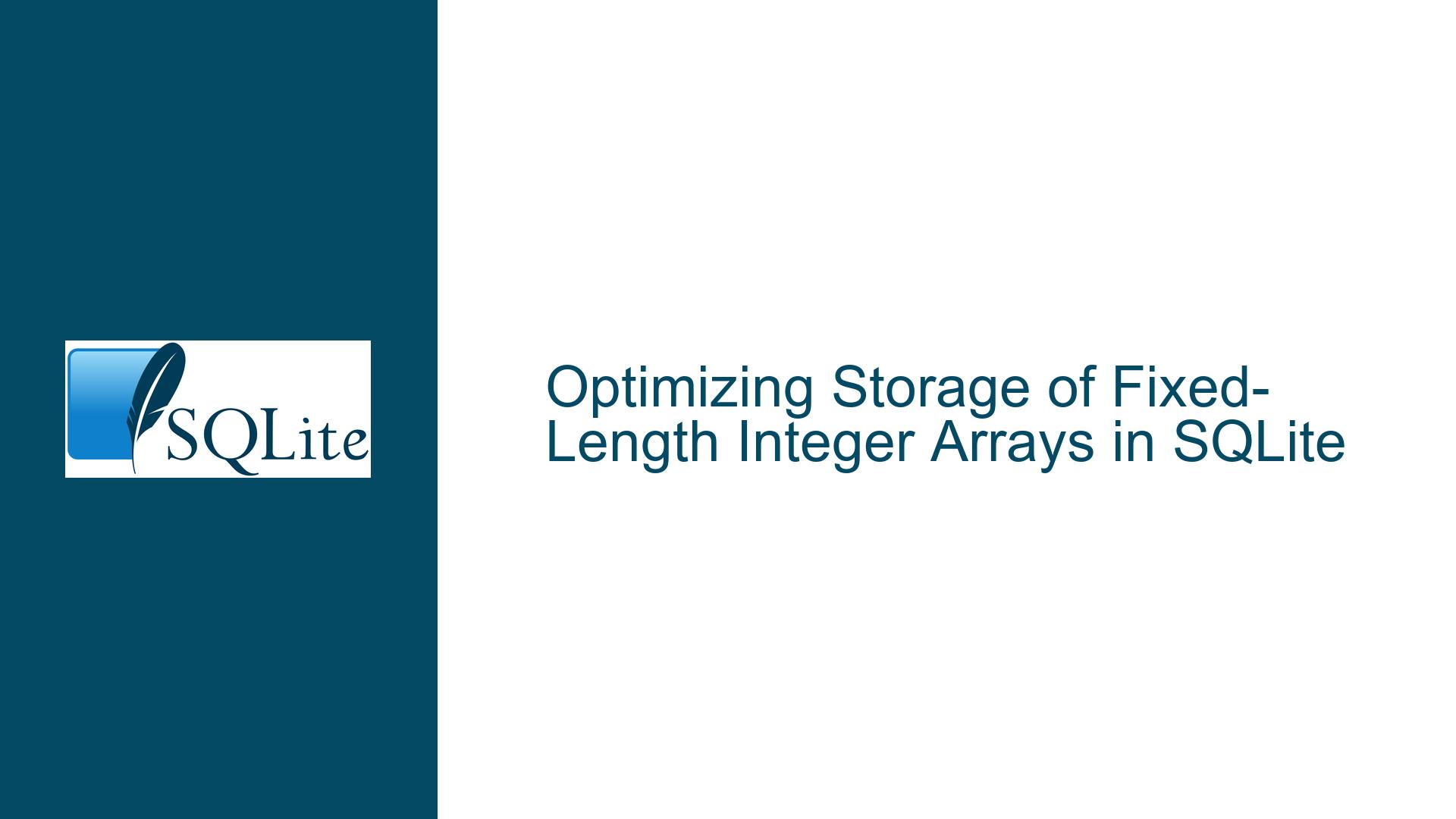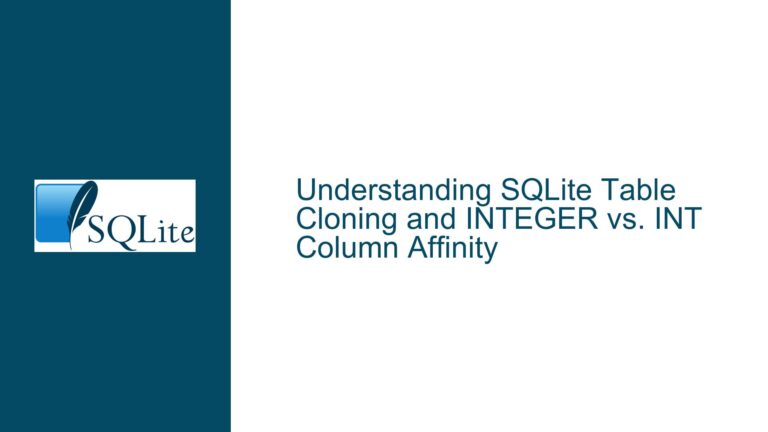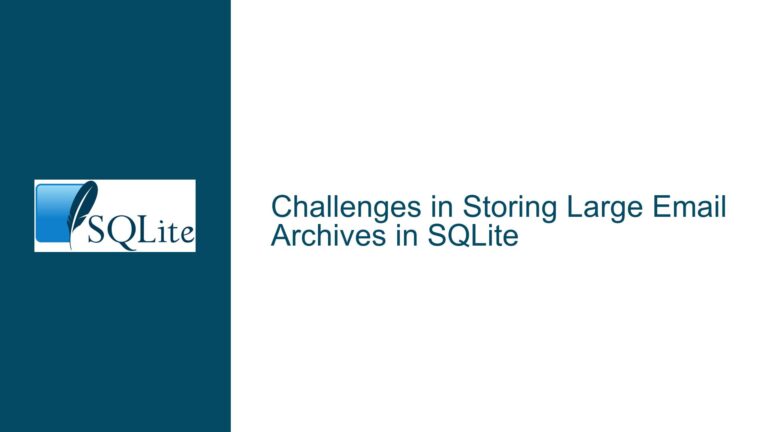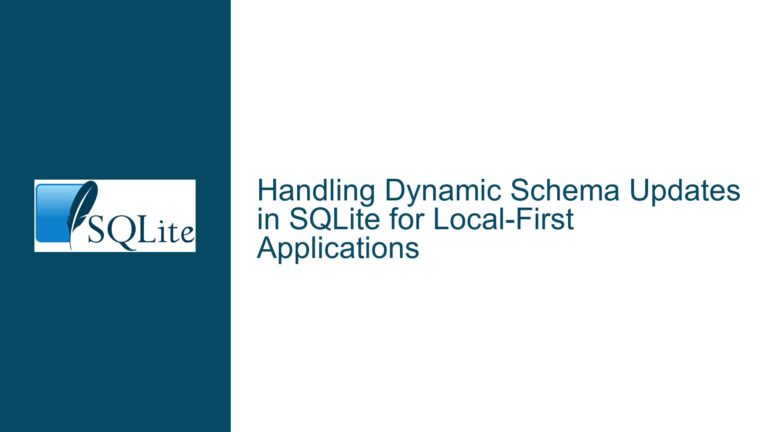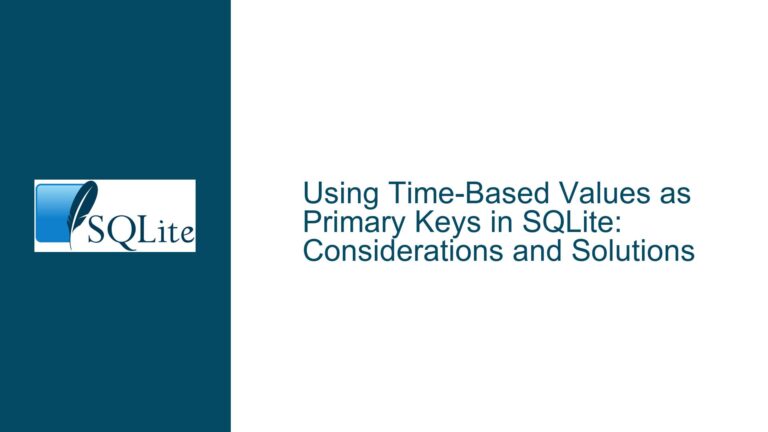Optimizing Storage of Fixed-Length Integer Arrays in SQLite
Issue Overview: Storing Fixed-Length Integer Arrays in SQLite
When working with SQLite, a common challenge arises when you need to store a fixed array of integers, particularly when the array length is constant and known in advance. In this scenario, the goal is to store an array of N 32-bit unsigned integers in a table where each row consists of an id and a value. The value column must store the entire array, and there is no need to access individual elements of the array. The primary concern is to determine the most efficient way to store this data, considering both storage space and retrieval performance.
The discussion revolves around several potential approaches, including using a BLOB type, converting the array to a string, or storing the array as JSON. Each method has its own trade-offs in terms of storage efficiency, ease of use, and performance. The core issue is to identify the most suitable method for storing fixed-length integer arrays in SQLite, especially when the array size is known and constant.
Possible Causes: Why Storage Method Matters for Fixed-Length Integer Arrays
The choice of storage method for fixed-length integer arrays in SQLite is influenced by several factors, including the nature of the data, the operations that will be performed on the data, and the constraints of the SQLite database engine. Understanding these factors is crucial to making an informed decision.
First, the nature of the data plays a significant role. Since the array is of a fixed length and consists of 32-bit unsigned integers, the storage method must accommodate this specific data type and size. Using a BLOB type is a natural choice because it allows for the storage of binary data, which can directly represent the array of integers. However, other methods, such as converting the array to a string or storing it as JSON, introduce additional overhead due to the need for serialization and deserialization.
Second, the operations that will be performed on the data are important. In this case, the requirement is to store and retrieve the entire array, without the need to access individual elements. This simplifies the problem somewhat, as there is no need to support operations that manipulate individual elements of the array. However, it also means that the storage method must be optimized for bulk storage and retrieval, rather than for individual element access.
Third, the constraints of the SQLite database engine must be considered. SQLite is a lightweight, embedded database engine that is designed for simplicity and efficiency. It does not support some of the more advanced data types and operations that are available in larger database systems. As a result, the storage method must be compatible with SQLite’s capabilities and limitations.
Finally, the potential for future changes in the data or requirements should be considered. While the current requirement is to store a fixed array of integers, it is possible that the requirements could change in the future. For example, there might be a need to store arrays of different lengths or to access individual elements of the array. The chosen storage method should be flexible enough to accommodate such changes, if necessary.
Troubleshooting Steps, Solutions & Fixes: Choosing the Right Storage Method for Fixed-Length Integer Arrays
When it comes to storing fixed-length integer arrays in SQLite, there are several approaches that can be taken, each with its own advantages and disadvantages. The following sections will explore these approaches in detail, providing guidance on how to choose the right storage method for your specific needs.
Using BLOB for Binary Storage of Integer Arrays
One of the most straightforward methods for storing a fixed array of integers in SQLite is to use the BLOB (Binary Large Object) data type. A BLOB can store binary data directly, which makes it an ideal choice for storing arrays of integers. Since the array is of a fixed length, the size of the BLOB can be predetermined, which allows for efficient storage and retrieval.
To store an array of N 32-bit unsigned integers as a BLOB, you would first need to serialize the array into a binary format. This can be done using a programming language that supports binary data manipulation, such as C, Python, or Java. Once the array is serialized, it can be stored in the BLOB column of the SQLite table. When retrieving the data, the BLOB can be deserialized back into an array of integers.
The advantage of using a BLOB is that it provides a compact and efficient storage format for binary data. Since the array is stored in its raw binary form, there is no need for additional encoding or decoding, which can reduce overhead and improve performance. Additionally, because the array is of a fixed length, the size of the BLOB is known in advance, which allows for efficient storage allocation.
However, there are some drawbacks to using a BLOB. One potential issue is that the BLOB data type is not human-readable, which can make it difficult to inspect or debug the data. Additionally, if the array size changes in the future, the BLOB storage method may need to be modified to accommodate the new size. Finally, while SQLite does support BLOB operations, they are not as flexible as operations on other data types, such as text or integers.
Converting the Array to a String for Text Storage
Another approach to storing a fixed array of integers in SQLite is to convert the array to a string and store it in a text column. This method involves serializing the array into a string format, such as a comma-separated list of integers, and then storing the resulting string in the database. When retrieving the data, the string can be deserialized back into an array of integers.
The advantage of this method is that it is relatively simple to implement and does not require any special handling of binary data. Additionally, the text format is human-readable, which can make it easier to inspect and debug the data. However, there are some significant drawbacks to this approach.
First, storing the array as a string introduces additional overhead due to the need for serialization and deserialization. This can reduce performance, especially if the array is large or if there are many arrays to store. Second, the text format is less compact than binary storage, which can increase the storage requirements for the database. Finally, if the array size changes in the future, the string format may need to be modified to accommodate the new size, which can introduce additional complexity.
Storing the Array as JSON for Flexible Data Representation
A third approach to storing a fixed array of integers in SQLite is to use the JSON data type. JSON (JavaScript Object Notation) is a lightweight data interchange format that is widely used for representing structured data. SQLite has built-in support for JSON, which makes it easy to store and query JSON data.
To store an array of integers as JSON, you would first need to serialize the array into a JSON array format. This can be done using a programming language that supports JSON serialization, such as Python, JavaScript, or Java. Once the array is serialized into JSON, it can be stored in a text column in the SQLite table. When retrieving the data, the JSON string can be deserialized back into an array of integers.
The advantage of using JSON is that it provides a flexible and human-readable format for storing structured data. JSON is also widely supported, which makes it easy to work with in a variety of programming languages and environments. Additionally, JSON allows for more complex data structures, which can be useful if the requirements change in the future.
However, there are some drawbacks to using JSON. Like the string storage method, JSON introduces additional overhead due to the need for serialization and deserialization. This can reduce performance, especially if the array is large or if there are many arrays to store. Additionally, the JSON format is less compact than binary storage, which can increase the storage requirements for the database. Finally, while SQLite does support JSON operations, they are not as efficient as operations on other data types, such as integers or BLOBs.
Comparing the Storage Methods: BLOB vs. String vs. JSON
When choosing a storage method for fixed-length integer arrays in SQLite, it is important to consider the trade-offs between the different approaches. The following table summarizes the key differences between using a BLOB, converting the array to a string, and storing the array as JSON:
| Storage Method | Storage Efficiency | Performance | Human-Readable | Flexibility | Complexity |
|---|---|---|---|---|---|
| BLOB | High | High | No | Low | Low |
| String | Medium | Medium | Yes | Medium | Medium |
| JSON | Medium | Medium | Yes | High | High |
As the table shows, using a BLOB provides the highest storage efficiency and performance, but it is not human-readable and offers limited flexibility. Converting the array to a string offers a balance between storage efficiency, performance, and human-readability, but it introduces additional complexity due to the need for serialization and deserialization. Storing the array as JSON provides the most flexibility and human-readability, but it has lower storage efficiency and performance compared to the other methods.
Best Practices for Storing Fixed-Length Integer Arrays in SQLite
Based on the analysis above, the following best practices can be recommended for storing fixed-length integer arrays in SQLite:
Use BLOB for Maximum Efficiency: If storage efficiency and performance are the primary concerns, and there is no need for human-readability or flexibility, use a BLOB to store the array. This method provides the most compact and efficient storage format for binary data.
Use String for Simplicity and Readability: If human-readability and simplicity are important, consider converting the array to a string and storing it in a text column. This method is easy to implement and allows for easy inspection and debugging of the data.
Use JSON for Flexibility: If flexibility and support for complex data structures are important, consider storing the array as JSON. This method provides a flexible and human-readable format for storing structured data, but it comes with additional overhead.
Consider Future Requirements: When choosing a storage method, consider the potential for future changes in the data or requirements. If there is a possibility that the array size or structure may change in the future, choose a storage method that can accommodate such changes with minimal modification.
Optimize for Bulk Operations: Since the requirement is to store and retrieve the entire array, optimize the storage method for bulk operations. This may involve using a BLOB for efficient binary storage or using a text-based format that can be easily serialized and deserialized in bulk.
Test and Benchmark: Before finalizing the storage method, test and benchmark the different approaches to determine which one provides the best performance and storage efficiency for your specific use case. This may involve creating a prototype and measuring the performance of different storage methods under realistic conditions.
Conclusion
Storing fixed-length integer arrays in SQLite requires careful consideration of the trade-offs between storage efficiency, performance, human-readability, and flexibility. By understanding the strengths and weaknesses of each storage method, you can choose the approach that best meets your specific needs. Whether you opt for the compact and efficient BLOB storage, the simple and readable string storage, or the flexible and structured JSON storage, the key is to align your choice with the requirements of your application and the constraints of the SQLite database engine.
